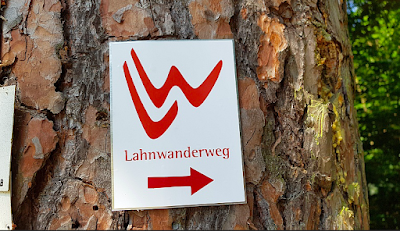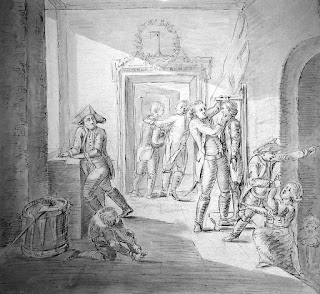That was the summer Goethe spent in Wetzlar ostensibly building up his legal bona fides. As with Goethe’s earlier legal education (first in Leipzig, then in Strassburg), there was less attention to the law and more to cultivating friendships and to literary matters. And as in Leipzig and in Strassburg, there was a lady. This time, however, the lady was already promised to another. Yet the acquaintance with
Lotte Buff (
die Braut) and her fiancé, Johann Christian Kestner (
der Bräutigam), was a close one, and the time they spent together that summer represented what Goethe called an authentic German idyll.
The story of this idyll, both the natural scenery and Goethe’s relationship with Kestner and Lotte, is beautifully rendered in Book 12 of
Dichtung und Wahrheit, and is reproduced in
The Sorrows of Young Werther. The description of Lotte in particular mirrors the character we know from the novel, as well as Goethe’s infatuation with her. She was the person who introduced him to life’s everyday world (
Alltagswelt), and they became inseparable companions in fields and meadows, in pastures and gardens. Sometimes Kestner even accompanied him, when not working! Goethe was the carefree one.
We can imagine how attractive the young Goethe must have been. He was gregarious, charming, attentive. He liked to talk about his ideas and to read aloud from what he was working on, but he was also open to learning from others. Kestner’s first sighting of him indicates he must have been jolly company. Kestner had gone on a walk with Friedrich Wilhelm Gotter, one of the founders of the
Göttinger Musenalmanach, when they came across Goethe lying on the grass under a tree in discussion with three men whom Kestner characterized as an Epicurean philosopher, a Stoic one, and a “middle thing” between the two. Kestner also said that Goethe’s main interests in life were the fine arts and sciences, but not the “bread” sciences.
The other figure in this story was
Karl Wilhelm Jerusalem, whom Goethe also considerately and courteously portrays in Book 12. He is one of several individuals whose name is still known to us today because he is the figure on whom Werther was modeled, including his blue tailcoat and yellow vest and his suicide due to unrequited love for a married woman. But we don’t get the whole story here; it takes up about five pages of fifty-six in Book 12 in the Hamburg edition.
In Book 13 Goethe states that, on hearing the news of Jerusalem’s suicide in November 1772, he immediately felt the similarity of his own intense experience in Wetzlar and Jerusalem’s and sat down to write the novel, without distinguishing between what was “poetic license” and reality. Isolating himself from friends and distractions, he finished
The Sorrows of Young Werther in four weeks. Of course, that was not the case, as the novel appeared in the summer of 1774.
In 1773 he was at work on many things, including the drama that first brought him to literary fame,
Gottfried von Berlichingen (
Götz von Berlichingen in the revised edition of the play, 1775). It is treated rather summarily in Book 13, with more attention to the money spent on the financing of the publication (although I think we are meant to understand that the events of the imperial coronation narrated in Book 5 refer to the decrepit Reich that forms the background of the play).
His own letters of 1773, when
Werther was probably gestating, do not reveal a man who was in great turmoil, but he was definitely feeling unanchored. He uses the word
Grille to refer to his behavior. But what’s love got to do with it? Clearly, Goethe had been infatuated with Lotte Buff in the summer of 1772. After leaving Wetzlar he was in an extensive correspondence with Kestner, and every single letter testifies to how lovable he found Lotte. In hindsight, one could assume that he was fairly obsessed with her, and at one point he responds to something Kestner wrote to him concerning his effusions.
But the letters don’t quite start out that way. There are many subjects covered in the letters, including the report of Jerusalem’s suicide in November 1772. On receiving the news from Kestner, he traveled to Wetzlar from Frankfurt with Georg Schlosser (soon to be his brother-in-law) to obtain more news. Not long thereafter, Kestner sent him a long report of the details of the events preceding the suicide and the suicide itself, which would two years later appear in The Sorrows of Young Werther.
The letters to Kestner, by the end of 1772 (a long Christmas letter), seem instead to show him trying out the matter of love, as he had done in correspondence with Behrisch in Leipzig in 1767, which resulted in his earliest poetry. This time, however, even though Goethe may have been besotted with Lotte Buff, it was not so torturous as with Kätchen Schönkopf. He was now almost ten years older and wiser: “It’s physical/Only logical/You must try to ignore that it means more than that.”
Most scholarship considers that he began writing the novel in January 1774, right after the marriage of Maximiliane von la Roche, she of the brown-eyed Lotte in
Werther. However, in October 1773 he wrote to Johann Fahlmer (later his sister-in-law) that his “authorship” was an inconstant thing. He had been working on various pieces, but nothing had come to fruition. And then: “
Ein schöner neuer Plan hat sich in meiner Seele aufgewickelt zu einem grosen Drama.” Drama, of course, could refer to the play
Clavigo, which would also appear in 1774, but it could also apply to the drama in prose. Could it have been the news that Max was going to marry that spurred him?
Since Goethe relied on so many documentary sources in writing
Dichtung und Wahrheit, was it likely that he conflated the date of Jerusalem’s suicide (1772) and the period in which
Werther was written (late 1773–early 1774)? Perhaps it is the case that Goethe was inadvertently trying to establish a background for the reception of
Werther on its appearance. Thus, the long excursus in Book 13 concerning the state of the soul of young men (in particular) in Germany in the 18th century, including the effects of morose English poetry. Unlike himself, many of the readers of the novel did not distinguish between poetic license and reality. Some were said to have committed suicide in emulation of Werther.
 |
Werther reading Ossian to Lotte
|
I could write more, but this longwinded post concerning the genesis of
Werther must suffice, treating only a few of the many influences on him, at least in his own account, that began with his return from Strassburg to Frankfurt in 1771. Goethe liked company and most of all liked to read aloud his ongoing work to others. In Book 13 he writes of himself (in the third person) using another technique when alone, that of imaginary listeners. Such are my posts as I continue my investigation of the young Goethe:
Er pflegte nämlich, wenn er sich allein sah, irgend eine Person seiner Bekanntschaft im Geiste zu sich zu rufen. Er bat sie, nieder zu sitzen, ging an ihr auf und ab, blieb vor ihr stehen, und verhandelte mit ihr den Gegenstand, der ihm eben im Sinne lag.
Whenever he found himself alone, he would mentally summon someone he knew, ask that person to sit down, while he paced back and forth and discussed the subject that was on his mind.






































